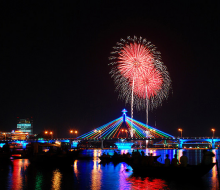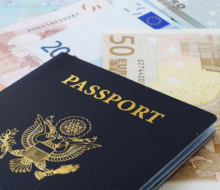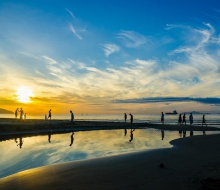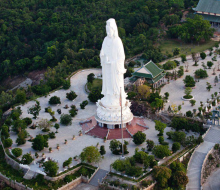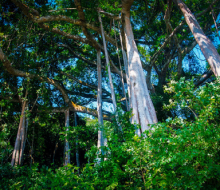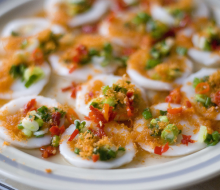Da Nang has long been a tourist city with many interesting entertainment places and attractive foods. There will be a lot of attractive programs in upcoming 2016 New Year. The following are some places for entertainment and eating in New Year holiday.
.jpg)
Exciting events
1. " Count Down Party"
Held on New Year's Eve (12.31.2015) at the square in front of 29/3 monument, count down party is an excellent art program with vibrant music that celebrates 2016 New Year. Especially, illustrated 3D space technology by 3D mapping lights along with art performances are used in this event. Many famous artists and the participation of DJ Angerfist (ranked 38 in 2015 worldwide DJ list) will bring you fascinating and unforgettable moment.
2. Beach firework festival.
The program is expected to be taken place at the East Sea Park from 18h to 0h30 from 01.01.2016 to 31.12.2015. This is the first time Da Nang holds this firework festival on the beach together with New Year countdown party and music programs with the participation of singer My Linh, Miu Le and MC Thanh Bach. There will be 553 shells fired from 176 guns, and 5 rotation effects
3. Tiger Remix Concert 2016
The program is organized by Tiger Beer Company on the evening of 02/01/2015 at the firework stage on Tran Hung Dao Street. A lot of famous artists with unique artistic performance will satisfied you.
.jpg)
Interesting places for New Year day
Here are some prominent places in Da Nang. Although you can come here at any time of year, New Year festival will be more special thank to more beautiful and splendid decoration.
For this occasion, you should visit major attractions like Son Tra Peninsula, Ba Na hills, Hai Van Pass, Marble Mountain, Cham sculpture museum, Linh Ung Pagoda, Dragon Bridge, Han River Bridge, and some beaches like Pham Van Dong, My An, My Khe and Nguyen Tat Thanh.
.jpg)
These locations are accessible by cars or motorcycles. It’s more convenient to use motorcycle to Son Tra Peninsula and Hai Van Pass because you can easily stop for sightseeing and photography. In the afternoon you can explore Marble Mountain, Non Nuoc Pagoda, and Hoi An by night.
Moreover, you can ride to Ba Na hills. After arriving the first Ba Na terminal, you can have your motorcycles kept; then, buying tickets that includes the admission to amusement park for 550,000 VND/person; next, sitting on cable cars to the 1st Linh Ung pagoda; after that, coming to the 2nd cable car system to Morin top for amusement park and walking up the mountain for the entire Da Nang view. Besides, Ba Na can be reached by by buses or tours.
.jpg)
Da Nang by night sightseeing
Da Nang is very beautiful at night with sparkling lights and colorful bridges on Han River. Travelers can enjoy fire and water breathing Dragon Bridge at 21h on Saturday and Sunday or watch spinning Han River Bridge, romantic love bridge, and Carp becoming Dragon status.
Please set aside an evening to walk along Bach Dang street to enjoy the hectic but peaceful, leisurely but hurry city. On the other side of this street, there are a lot of bars and coffee shops where you can drink a cup of coffee or a bottle of beer and enjoy the beauty of Han River at night.
.jpg)
These are some coffee shops with beautiful views: À la carte, LeRio, Memory Lounge, Da Nang Souvenirs, and some rock music shops: On the Radio, Odin Rock, Kina Rock, and Unplugged.
Park Asia with thrilling games are suitable for young at the beginning of a year.
.jpg)
Exciting events
1. " Count Down Party"Held on New Year's Eve (12.31.2015) at the square in front of 29/3 monument, count down party is an excellent art program with vibrant music that celebrates 2016 New Year. Especially, illustrated 3D space technology by 3D mapping lights along with art performances are used in this event. Many famous artists and the participation of DJ Angerfist (ranked 38 in 2015 worldwide DJ list) will bring you fascinating and unforgettable moment.
2. Beach firework festival.
The program is expected to be taken place at the East Sea Park from 18h to 0h30 from 01.01.2016 to 31.12.2015. This is the first time Da Nang holds this firework festival on the beach together with New Year countdown party and music programs with the participation of singer My Linh, Miu Le and MC Thanh Bach. There will be 553 shells fired from 176 guns, and 5 rotation effects
3. Tiger Remix Concert 2016
The program is organized by Tiger Beer Company on the evening of 02/01/2015 at the firework stage on Tran Hung Dao Street. A lot of famous artists with unique artistic performance will satisfied you.
.jpg)
Interesting places for New Year day
Here are some prominent places in Da Nang. Although you can come here at any time of year, New Year festival will be more special thank to more beautiful and splendid decoration.For this occasion, you should visit major attractions like Son Tra Peninsula, Ba Na hills, Hai Van Pass, Marble Mountain, Cham sculpture museum, Linh Ung Pagoda, Dragon Bridge, Han River Bridge, and some beaches like Pham Van Dong, My An, My Khe and Nguyen Tat Thanh.
.jpg)
These locations are accessible by cars or motorcycles. It’s more convenient to use motorcycle to Son Tra Peninsula and Hai Van Pass because you can easily stop for sightseeing and photography. In the afternoon you can explore Marble Mountain, Non Nuoc Pagoda, and Hoi An by night.
Moreover, you can ride to Ba Na hills. After arriving the first Ba Na terminal, you can have your motorcycles kept; then, buying tickets that includes the admission to amusement park for 550,000 VND/person; next, sitting on cable cars to the 1st Linh Ung pagoda; after that, coming to the 2nd cable car system to Morin top for amusement park and walking up the mountain for the entire Da Nang view. Besides, Ba Na can be reached by by buses or tours.
.jpg)
Da Nang by night sightseeing
Da Nang is very beautiful at night with sparkling lights and colorful bridges on Han River. Travelers can enjoy fire and water breathing Dragon Bridge at 21h on Saturday and Sunday or watch spinning Han River Bridge, romantic love bridge, and Carp becoming Dragon status.Please set aside an evening to walk along Bach Dang street to enjoy the hectic but peaceful, leisurely but hurry city. On the other side of this street, there are a lot of bars and coffee shops where you can drink a cup of coffee or a bottle of beer and enjoy the beauty of Han River at night.
.jpg)
These are some coffee shops with beautiful views: À la carte, LeRio, Memory Lounge, Da Nang Souvenirs, and some rock music shops: On the Radio, Odin Rock, Kina Rock, and Unplugged.
Park Asia with thrilling games are suitable for young at the beginning of a year.
Chia sẻ



